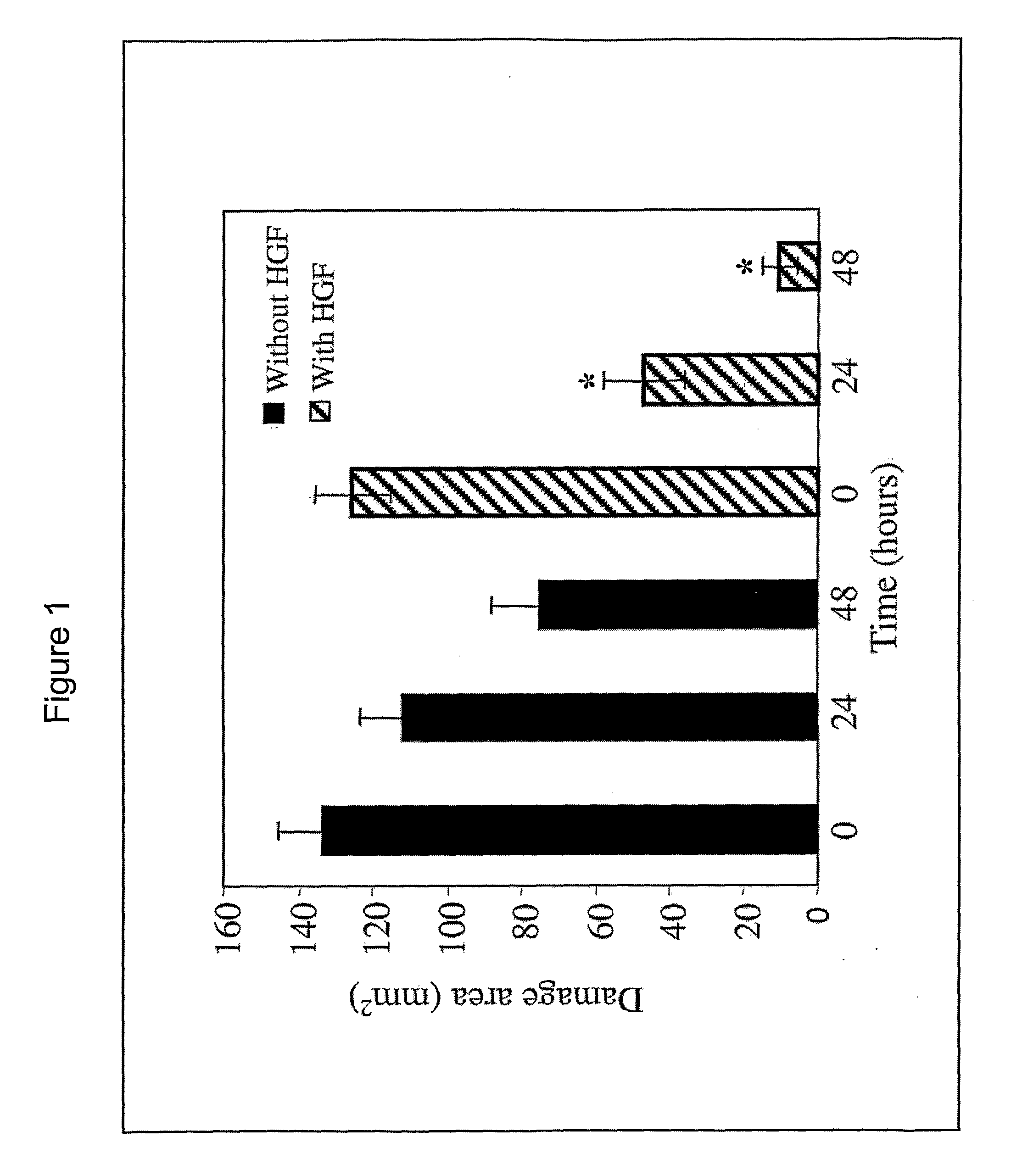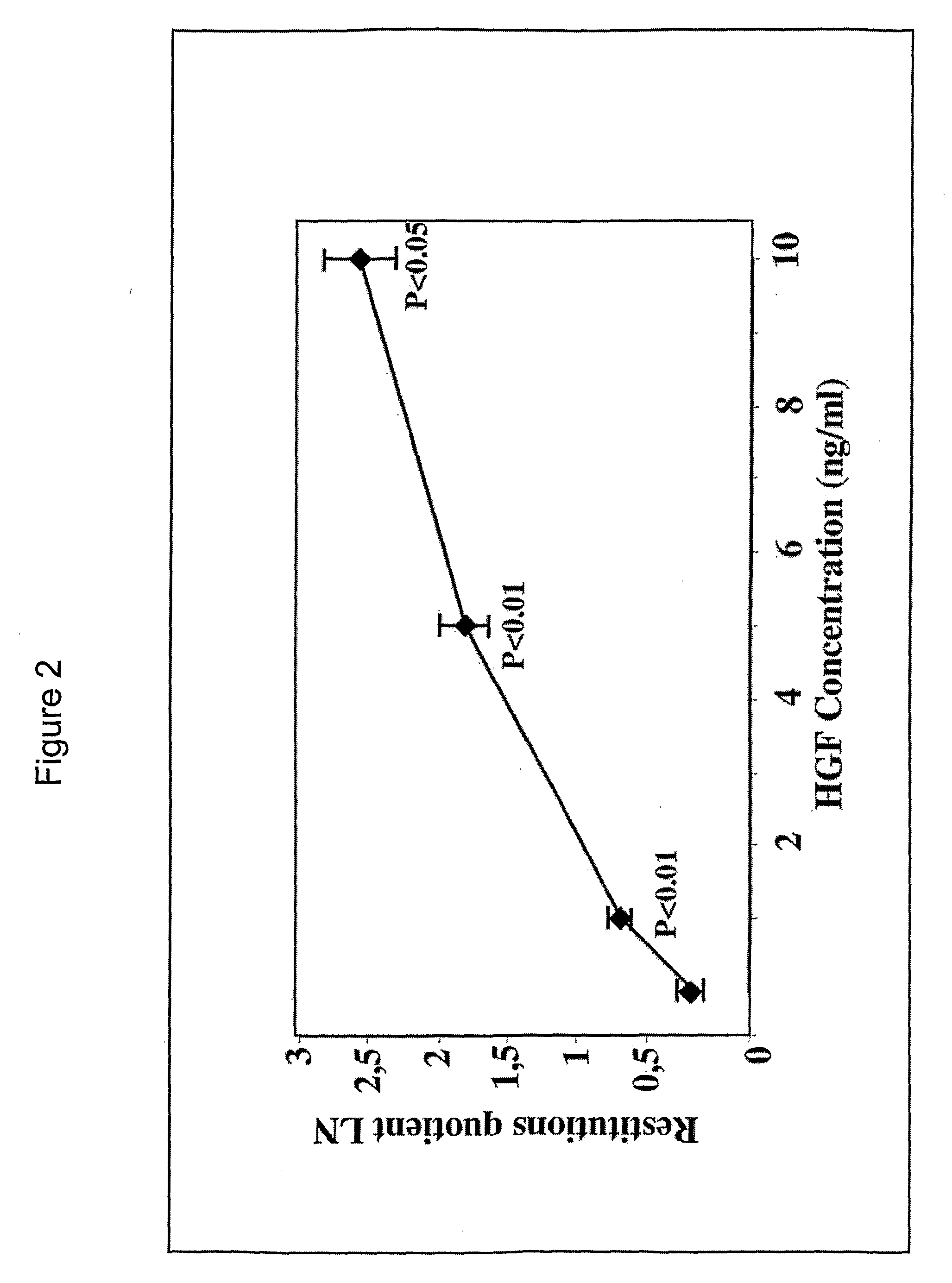Assessment of Biological Activity of Hepatocyte Growth Factor (Hgf)
a technology biological activity, which is applied in the field of methods for evaluating the biological activity of hepatocyte growth factor, can solve the problems of tissue regeneration and growth, and achieve the effects of increasing the coverage of the injured nude area, reducing the adhesion of cells to each other, and increasing cell motility
- Summary
- Abstract
- Description
- Claims
- Application Information
AI Technical Summary
Benefits of technology
Problems solved by technology
Method used
Image
Examples
example 1
Effects of Hepatocyte Growth Factor in Accelerating Restitution of Damaged Mouse Melanocyte Cells In Vitro
[0030]The following materials and conditions were used.
Cells: CCL-53.1 adherent epithelial cells derived from mouse skin, melanocytes, melanoma were obtained from American Tissue Cell Collection (ATCC, Manassas, Va., USA) and were used at passages 3-32.
Growth factors: Recombinant Hepatocyte growth factor (HGF) was a kind gift from professor T Nakamura, Osaka, Japan. HGF was also obtained commercially (R D Systems, Lot: QF031062), Fibroblast growth factor (FGF, R D Systems, Lot: EX164011), Platelett-derived growth factor (PDGF, R D Systems, Lot: D332071), Keratinocyte growth factor (KGF, R D Systems, Lot No: J0164021), Epidermal growth factor (EGF, R D Systems, Lot: HLM114031).
[0031]As the recombinant HGF obtained from professor Nakamura was shown to be very effective in treatment of chronic ulcers in patients (Example 4) it has been used herein as a positive control for biologic...
example 1a
Cell Proliferation
[0033]The ratio of CPM (count per minute) in control and HGF treated wells was as followed: 2 ng HGF / control=1.1 (0.95-1.20); 5 ng HGF / control =1.1(1.04-1.18) and 15 ng HGF / control=1.15 (0.99-1.23). Cell proliferation in the epithelial cell line (CCL-53.1) was therefore not significantly increased by recombinant HGF as assessed by determination [3H]-thymidine uptake.
example 1b
Restitution of Injured Area
[0034]The effect of HGF on restitution of injured monolayer was assessed using an in-vitro wounding model. The uncovered area decreased after 24 and 48 hours. The ratio of the measured bare area at the time of damage and after 24 hours by HGF was significantly higher (at the time of injury=125.25±10.08 mm2, after 24 hours=46.73±11.03 mm2, ratio=2.65, p2, ratio=11.91) compared to control (at the time of injury=133.77±11.7 mm2, after 24 hours =112.23±11.11 mm2, ratio=1.15 and after 48 hours 75±13.17 mm2, ratio=2.43) (FIG. 1). There were no significant differences between ordinary and serum-deprived medium in restitution of injured cells after addition of HGF. Significant enhancement of epithelial restitution was observed at low HGF concentration, 1 ng / ml. Increasing doses of HGF caused further increasing in restitutions rate up to 10 ng / ml (p<0.01 between control and 1 ng / ml, p<0.01 between 1 ng / ml and 5 ng / ml, p=0.05 between 5 ng / ml and 10 ng / ml) (FIG. 2). ...
PUM
| Property | Measurement | Unit |
|---|---|---|
| distance | aaaaa | aaaaa |
| concentration | aaaaa | aaaaa |
| temperature | aaaaa | aaaaa |
Abstract
Description
Claims
Application Information
 Login to View More
Login to View More - R&D
- Intellectual Property
- Life Sciences
- Materials
- Tech Scout
- Unparalleled Data Quality
- Higher Quality Content
- 60% Fewer Hallucinations
Browse by: Latest US Patents, China's latest patents, Technical Efficacy Thesaurus, Application Domain, Technology Topic, Popular Technical Reports.
© 2025 PatSnap. All rights reserved.Legal|Privacy policy|Modern Slavery Act Transparency Statement|Sitemap|About US| Contact US: help@patsnap.com



